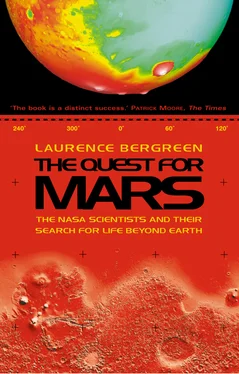1 ...7 8 9 11 12 13 ...25 We head north until we reach an enormous glacier: Langjökull. On the other side, its summit obscured by cloud cover, is the great volcano known as Ok. The stony, dusty ground, reddish brown, contrasts with the huge wall of ice. I slowly become aware of the landscape’s resemblance to images of the Martian icecaps, those vast dull white fields rising out of the reddish Martian desert. The more we look, the more striking the resemblance to the northern latitudes of Mars. Our isolation feels complete. No birds or cars disturb the pure silence. No airplanes streak by overhead; the atmosphere is untarnished by plumes of smoke. The spectral glacier rises impressively from the dark red rock, its façade reaching into the clouds and mist, massive, gloomy, impersonal, hypnotic. Nearly everything looks alien and supremely indifferent to the two tiny human figures in the midst of this vast, primeval sanctuary. Take all the measurements you want of Mars, but walking through this strange and unnerving place suggests, as nothing else can, what it would be like to traverse the surface of the Red Planet.
Suddenly a pair of bicyclists disturbs us, a man and a woman, en route to a distant town or campsite. It’s a relief to share the oppressively majestic Martian landscape with others, even briefly. And then they’re gone, gliding into the distance on their bicycles, and we’re alone again. For once, Jim is speechless. We return to the car in silence.
When we reach Keflavik, Jim drives us over to the tarmac, saluting smartly whenever he passes a military guard. At last, the afflicted P-3 aircraft is here. It looks all right from a distance, but a closer inspection reveals oil leaking from the nose, creating an embarrassing, 125-foot long stain on the ground, beginning directly beneath the aircraft. There’s talk that the Keflavik Naval Air Station may insist the P-3 leave immediately so that it does not foul the runway.
Jim trots to the base’s weather station, where the latest satellite data are available. The weather station glitters with state-of-the art equipment; the place is so big and solid it looks like the bridge on an aircraft carrier. Although it’s sunny here in Keflavik today, the instruments reveal there is a weather front moving in, and steel gray clouds are visible on the horizon. It’s now about 3:30 in the afternoon, and sometime after 5:00, the plane is supposed to be in the air, on a six-hour mapping mission. Right away Jim sees it will likely be too cloudy to take data over Surtsey, so instead they’ll survey a floodplain known as the Sandur, located in the Eastern portion of Iceland. Given the weather and mechanical constraints, this will likely be the only day they will be able to take measurements.
Jim sits at a computer terminal in the Weather Station and begins composing a report to the base commander about his activities here in Iceland; at the same time, he chatters with me and an affable young naval attaché. He types rapidly, never making a mistake – “…As part of NASA’s continuing research interests in Iceland as a microcosm for global Earth environmental change and as a natural analogy for landscapes on Mars, an aircraft remote sensing campaign was conducted during the period from 20 July to 26 July, 1998. A NASA P-3 aircraft, outfitted with two scanning airborne laser altimeters, an ice penetrating radar, a nadir-viewing digital video imaging system, and multiple GPS receivers, was deployed to Iceland …” – and when he’s done, he rips his report from the typewriter, drops it off at the base commander’s office, and trots back to the P-3.
He bounds up the ladder to the cabin, which looks like the inside of an Eyewitness News van, crammed with television monitors and wires, strewn with Styrofoam coffee cups, and devoid of creature comforts. Within this funky hi-tech cave, he confers with the navigator, Jon Sonntag, and the two pilots. They plot coordinates. They discuss backup plans. They propose flight paths. “Here’s the game plan,” Jim says, tracing the route on the map with his finger. “Take off, come around … here … and then straight to the Sandur. Surtsey looks really good. Now come over here and do this middle line. That’s the number one priority. If that looks good, see if we can do the north line. At that point, we call the option for doing the south line. If it looks like there are no clouds over this icecap, we might be able to sneak up and come around. In the past we always went way up here and came down. I’m afraid that, unless we can throw a real sharp turn, we can’t do it. We fly at eighteen hundred feet.”
All they need is a working airplane. José’ is the mechanic responsible for maintaining the leaky P-3. He stands about five foot three or maybe four, stocky, with a scruffy, uncertain beard, and a good-natured grin. Jose’, who’s American, likes his wine, and he likes his beer. In the evenings, he’s the first to hit the strip bars of Reykjavik, such as they are. The fate of the P-3 now rests in his hands. Even as they tell me stories of his wild doings, everyone about to fly on this plane expresses confidence in him. (Frankly, I wouldn’t let him near my car.) He works slowly and methodically on the plane, and when he’s done, declares it good to go. The engines roar to life.
The white P-3, with Jim inside, taxis far out onto the tarmac and ascends to the skies over Iceland. While they’re in the air, the pilots do most of the work, for they have to maintain alignment not only with the surface of the planet below but with the Global Positioning System satellite above. This means the plane can’t wander more than six feet off course. They map the Sandur, and, weather predictions to the contrary, they do Surtsey, as well. They do their mapping with reference not to the Earth’s surface, which is always shifting, but to Earth’s center, which is about as close to an absolute, fixed point as you can get.
Mission accomplished, the P-3 returns to Keflavik after midnight. To everyone’s surprise, the aircraft has performed flawlessly that evening, laying down precise tracks over Surtsey and a glacier to the north. “We laid down fourteen lines!” Jim announces. “It was fantastic. Staggered just the way we wanted them. And the weather was great. It was sunny and clear on the island. I’ve got digital video, nose cone video. We’re going to have the best map of Surtsey ever made, no question. The flight was as tranquil as bath water. Even the leak stopped by the time we landed.”
To celebrate, Jim and Jon Sonntag and I go out for a beer. After a long day’s work in the field, no self-respecting NASA scientist thinks of anything but a beer. The drinking etiquette is to avoid brand names and even recognizable microbreweries in favor of obscure local product. Eventually, we find a little place overlooking the large bay, where they serve frosted glass tankards of Viking, an Icelandic beer. We sit in front of a picture window overlooking the steel gray expanse of Keflavik Bay. A few lights flicker across the water, but not many.
Having just spent the last five hours in geological nirvana, Jim talks on and on about what a great mission it’s been, while Jon brings up a slightly different subject: the kind of woman he’d like to meet and settle down with. He’s from Houston, but he wants to meet a different kind of girl from the ones he’s known in Texas. Maybe here, in Iceland. Maybe even in New York City. He asks me about the women in New York, where I live, and I tell him the best thing to do is visit and see for himself. He pauses and smiles shyly, contemplating the prospect. He just might do that.
This type of talk makes Jim uncomfortable. Throughout our time in Iceland, a lot of stray remarks have escaped his lips about power tools, about the power washer he was using just the other day with his son Zack (“That thing was so powerful,” he said with genuine conviction, “that it could take the paint right off a car”), about the Ford F-150 pickup truck he’d like to own, and about a Hummer (“How much do those things cost?”), but nothing about women. Which doesn’t mean that women don’t look at him . They do, indeed. His handsome dark Irish looks, his snappy NASA flight jacket, and his politeness combined with an occasional air of confusion tend to attract women.
Читать дальше












